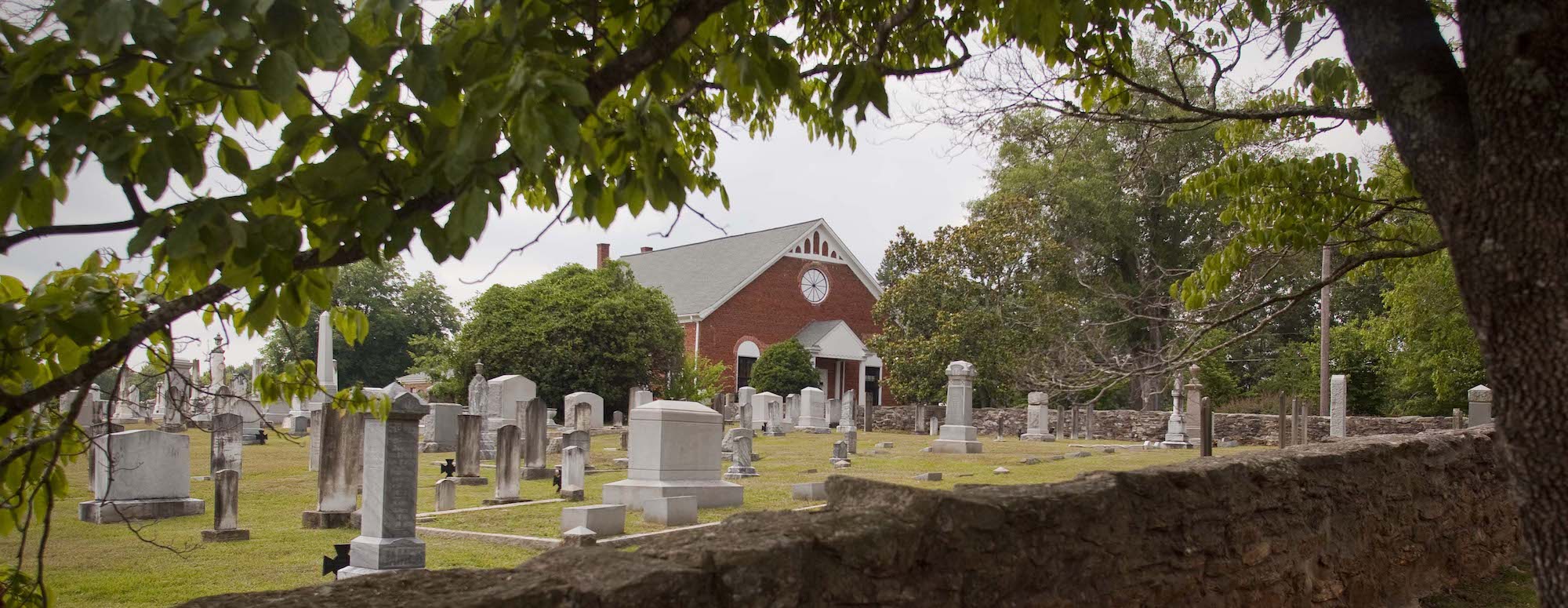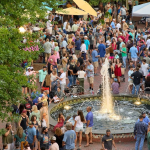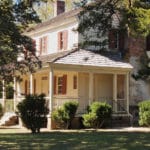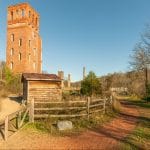Local Cemeteries: Two-and-a-Half Centuries of History
By Brad Steinecke, produced in cooperation with the HubCity Writers Project.
On a frigid morning in January, an older woman walks into the Kennedy Room at the Spartanburg Headquarters Library. After a recent visit to the cemetery, she has resolved to find whatever information she can summon on her dear grandmother—a woman gone for more than fifty years, but still deeply loved. Now that she’s at the library, she’s excited to learn more: to shine a light on Grandma’s triumphs and heartbreaks, to maybe glimpse her character, and to better appreciate the context and influences in her life.
This scene plays out many times a week in the Kennedy Room, and cemeteries almost always play a part in the narrative. They are places of reflection and memory, almost outside of time. Even beyond their usefulness in communing with ghosts and family history, cemeteries are fascinating spaces.
 Spartanburg has some wonderful cemeteries that cover some two and a half centuries of funeral and land-use trends. In Spartanburg’s earliest days, the dead were placed in small fieldstone- marked family graveyards on the edges of farm fields. A surviving example is open to the public at Walnut Grove Plantation, but they remained common in rural communities even a century ago. It’s not too difficult to find them. At Walnut Grove, the dead are arranged in neat rows with the leading family’s tall, elaborately-carved marble headstones at the upper end of the cemetery. All the other stones are unmarked, low-lying rocks, likely marking the unremembered bodies of slaves and tenement families.
Spartanburg has some wonderful cemeteries that cover some two and a half centuries of funeral and land-use trends. In Spartanburg’s earliest days, the dead were placed in small fieldstone- marked family graveyards on the edges of farm fields. A surviving example is open to the public at Walnut Grove Plantation, but they remained common in rural communities even a century ago. It’s not too difficult to find them. At Walnut Grove, the dead are arranged in neat rows with the leading family’s tall, elaborately-carved marble headstones at the upper end of the cemetery. All the other stones are unmarked, low-lying rocks, likely marking the unremembered bodies of slaves and tenement families.
 As churches gained a foothold in the early nineteenth century, most rural churches set aside land for a churchyard cemetery. This probably remains the most common form of cemetery through the county. The cemeteries at Nazareth Presbyterian (near Reidville) and Liberty United Methodist (on Highway 221 past Whitney) are great examples of early church cemeteries established in the 1700s that remain in use. A somewhat later but exceptionally good example of an old church cemetery is at the Church of the Advent in downtown Spartanburg. With its rough- hewn stonework and crowded tombstones, more than any other church in Spartanburg, it has the feeling of an Old World churchyard.
As churches gained a foothold in the early nineteenth century, most rural churches set aside land for a churchyard cemetery. This probably remains the most common form of cemetery through the county. The cemeteries at Nazareth Presbyterian (near Reidville) and Liberty United Methodist (on Highway 221 past Whitney) are great examples of early church cemeteries established in the 1700s that remain in use. A somewhat later but exceptionally good example of an old church cemetery is at the Church of the Advent in downtown Spartanburg. With its rough- hewn stonework and crowded tombstones, more than any other church in Spartanburg, it has the feeling of an Old World churchyard.
Originally Spartanburg had two segregated “village” cemeteries, probably both established in the early 1800s.
 The white cemetery remains on Magnolia Street, then the primary corridor of Spartanburg’s wealthiest families. William “Singin’ Billy” Walker, composer of many of the shaped-note tunes making up the hymnal “The Southern Harmony” is buried there, as is Confederate Lieutenant John Evins, who later served in the U.S. House of Representatives.
The white cemetery remains on Magnolia Street, then the primary corridor of Spartanburg’s wealthiest families. William “Singin’ Billy” Walker, composer of many of the shaped-note tunes making up the hymnal “The Southern Harmony” is buried there, as is Confederate Lieutenant John Evins, who later served in the U.S. House of Representatives.
Over the years Magnolia Street Cemetery suffered from expanding railroad lines and unchecked vandalism, but many stones remain intact, and it’s worth the visit to commune with many of Spartanburg’s earliest citizens. Just don’t bring any watermelon with you! After watermelon vines kept sprouting, a law was passed to prohibit eating watermelon in the cemetery. So far as I know, that law remains on the books.
The city’s black cemetery once lay near the railroad crossing on West Main Street, close to one of the town’s larger enclaves of slaves and freedmen. In 1910, what remained of this cemetery was moved to a new plot on the Southside of town, where it now forms the nucleus of the Cemetery Street Cemetery.
By the 1880s, white Spartanburg had outgrown the crowded little yard on Magnolia Street and cemeteries had come to be seen as park-like, semi-recreational spaces. Oakwood Cemetery was established just east of Converse College and its design incorporated ornamental trees and winding paths. Simpson Bobo, who signed the order of secession before the Civil War, is buried there, as is Dexter Edgar Converse, founder of Converse College, and a host of city leaders and textile barons named Montgomery, Cleveland, Chapman, Twichell, Floyd and DuPre. There’s a potter’s field in back with unmarked graves of the city’s poor or imprisoned. The first Jewish cemetery in the city is on the west side of Oakwood.
With more than 5,000 locals buried there, Oakwood still remains in limited use and its picturesque gateway, striking stonework, and rolling landscape make it ideal for morning walks, but beware of thrill-seeking teenagers at night.
Other twentieth century cemeteries dot the map in Spartanburg County, including Greenlawn, Heritage Memorial Gardens, Lincoln Memorial and others. These retain the park-like atmosphere of Oakwood, but often on a larger scale. As cremation gains popularity and an environmental ethic spreads, I wonder whether cemeteries such as these will someday give way to something else, some new sacred outdoor space where we can pause from our daily routines to feel the winds of eternity.
Brad Steinecke, Produced in cooperation with the HubCity Writers Project.
 Brad Steinecke is a Spartanburg native who works as an archivist and historian for the Spartanburg County Public Libraries. He, his wife and son live in Hampton Heights.
Brad Steinecke is a Spartanburg native who works as an archivist and historian for the Spartanburg County Public Libraries. He, his wife and son live in Hampton Heights.






